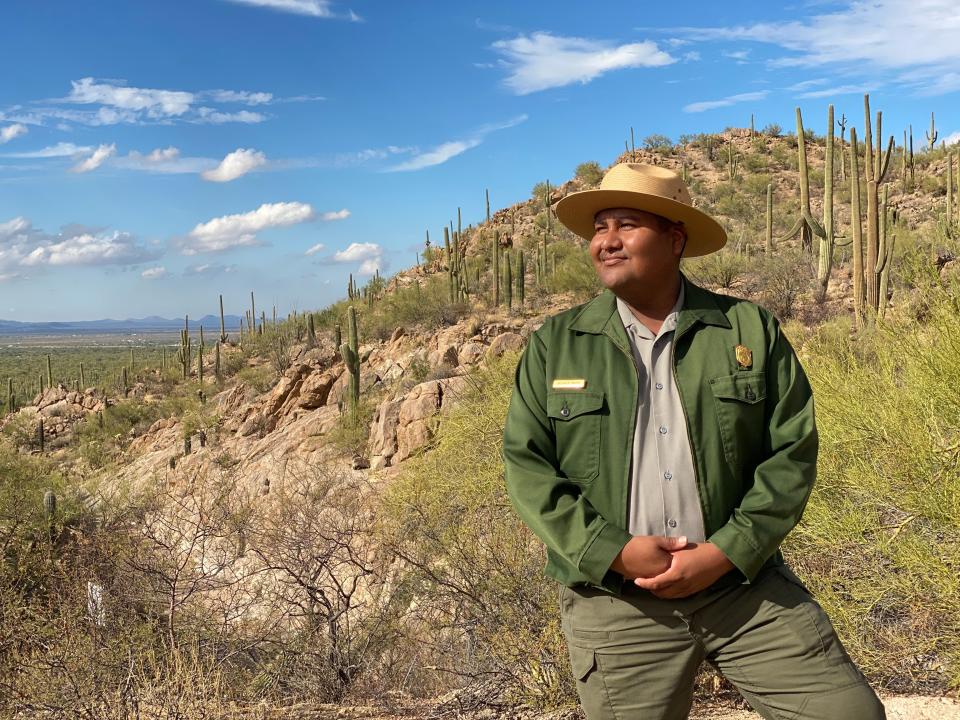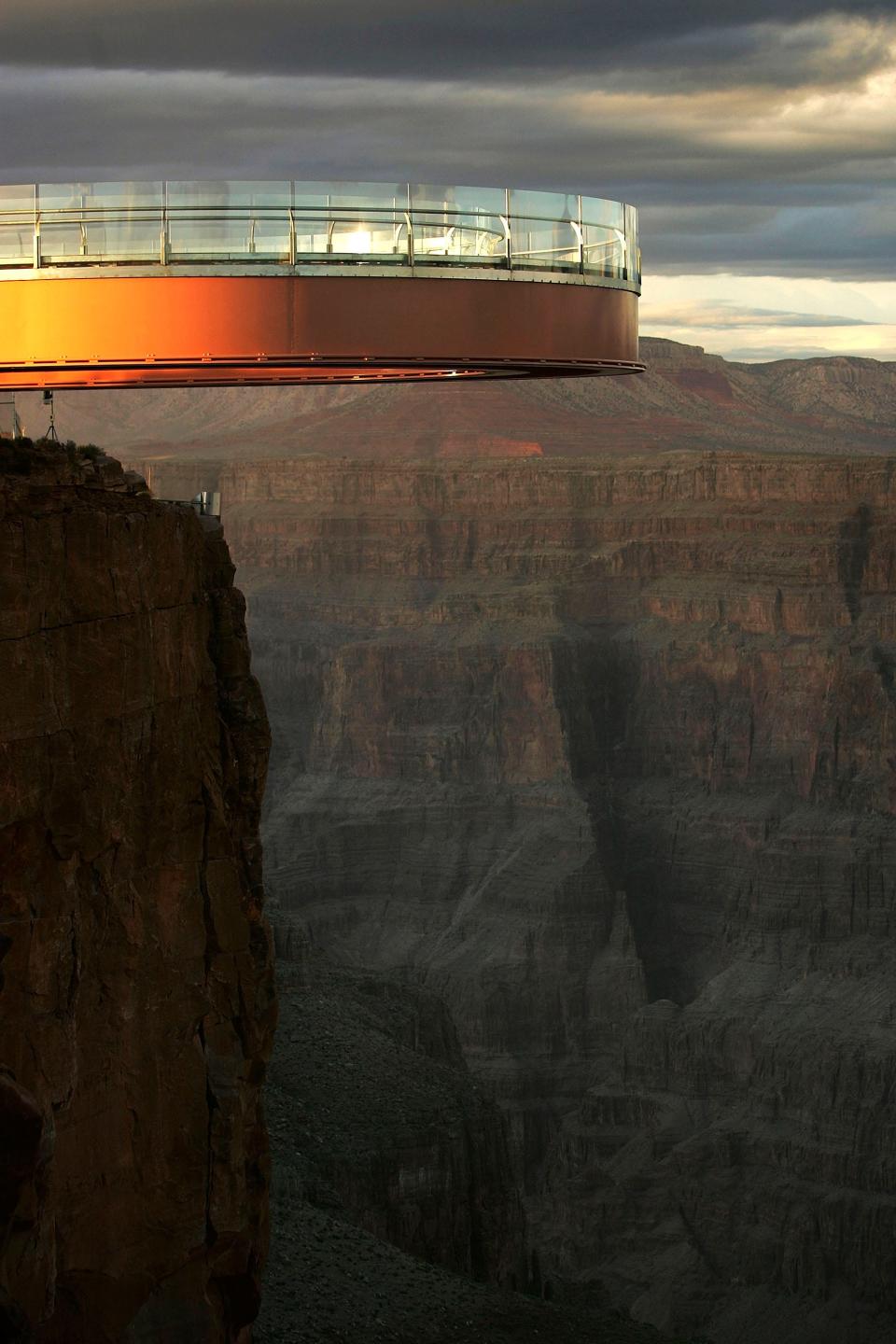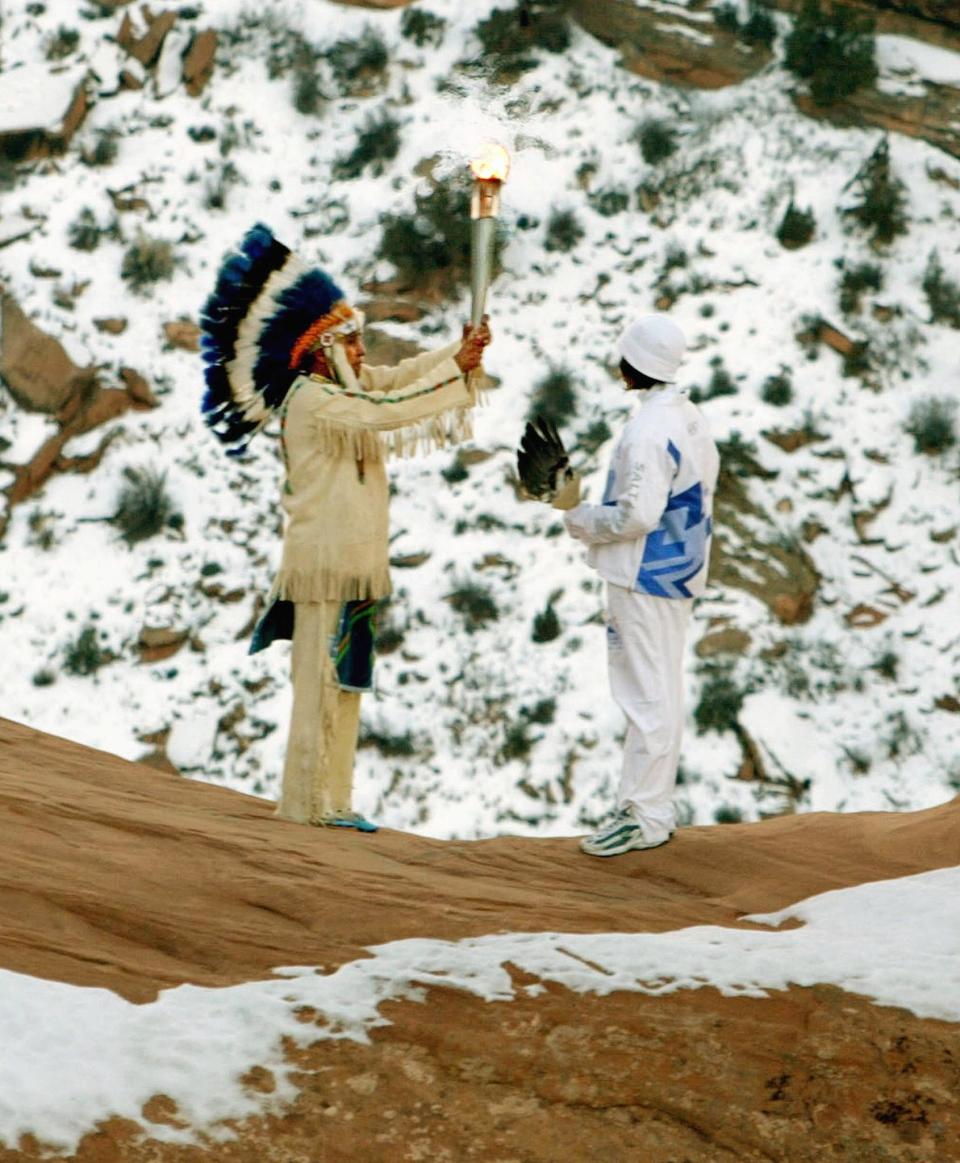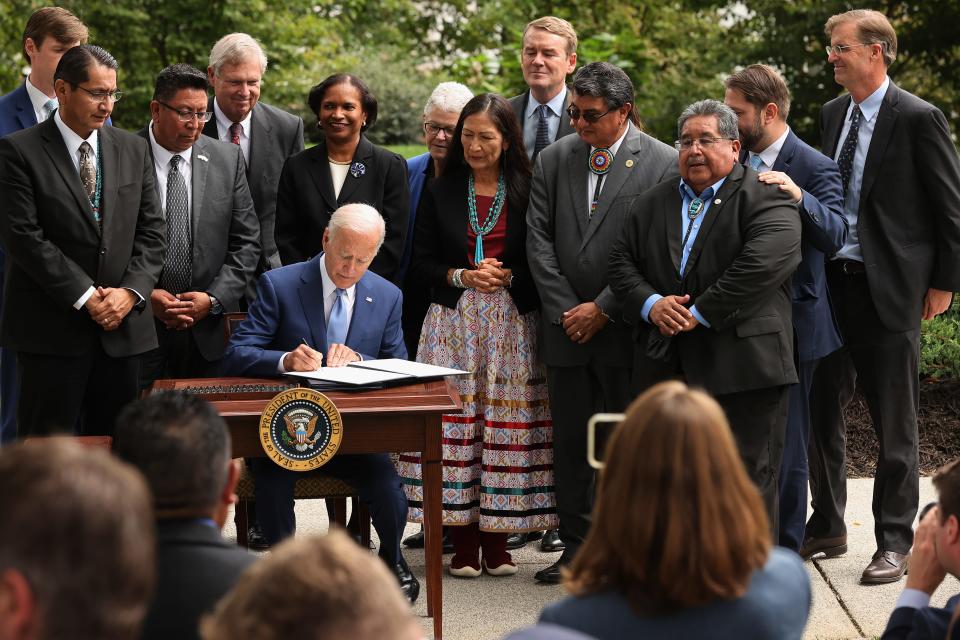US national parks have a troubling history. A new project aims to do better.
- Oops!Something went wrong.Please try again later.
The rocky trail crunched and crackled under Chase Iron Eyes’ shoes as he traced a path earlier this week through Bear Butte State Park in South Dakota, a place to which he’s regularly returned since he was a young boy raised on the Standing Rock Reservation.
Iron Eyes, a 46-year-old lawyer and Indigenous rights activist, was 9 when a medicine man taught him traditions he’s maintained since, in the wake of the tribe’s annual sun dance ceremony at the park. Distinguished by its towering igneous rock formation, the site remains sacred to multiple tribal nations, including the Lakota and Cheyenne.
“A lot of different tribal nations conduct their fasting ceremony or vision-questing ceremony here,” Iron Eyes said by phone as he walked. “My grandmother used to bring me here when I was tiny.”
Similarly, Iron Eyes said, the lands that now form the country’s national parks have histories as Indigenous homelands and sacred sites. As summer visitors head out to explore places such as Yellowstone, Devils Tower and the Grand Canyon, the Lakota People’s Law Project, where Iron Eyes is director, has launched an effort to compensate tribes long connected to those sites.
“All national parks sit on native lands,” said Brooke Neely, a research fellow at the Center of the American West at the University of Colorado Boulder. “The very creation of U.S. national parks was part of the larger project to displace and dispossess native people of their lands.”

The law project says its Sacred Defense National Parks and Monuments Initiative will work like this: Visitors, or anyone who wants to, can donate on the project website and designate a particular park or monument site. The funds will then be distributed annually to participating tribes with historical associations to those sites.
Project leaders hope the funds will help native peoples share their own narratives about the lands, expanding public awareness of their historical tribal connections and promoting their conservation.
“When you visit Devils Tower, or, as we know it, Mato Tipila, we want to tell you our stories about it,” Iron Eyes says in a video about the Wyoming landmark posted on the initiative's website. “We don’t want you to just read some one-pager at the interpretive center. We want you to experience these sacred sites, sacred lands and sacred waters as we do.”
More than 325 million people visited national parks and monuments last year, which helped surrounding communities reap economic benefits of $50 billion in 2022 and supported more than 378,000 jobs.
How the Sacred Defense initiative works
The Sacred Defense initiative launched with 14 national sites, with plans to add more over time. All donated funds will be distributed annually to participating tribal nations, Iron Eyes said.
In addition to Yellowstone, Devils Tower and the Grand Canyon, the list includes:
In Utah, Arches National Park, Zion National Park and Bears Ears National Monument;
Hawaii's Haleakalã and Hawaii volcanoes;
Crater Lake National Park in Oregon;
Death Valley National Park in California;
White Sands National Park in New Mexico;
Grand Teton National Park in Wyoming;
Rocky Mountain National Park in Colorado; and
Wind Cave National Park in South Dakota.
Learning more: From Acadia to Zion: What travelers should know about each of America's national parks
“National parks are often landscapes of exceptional awe and wonder, so it makes sense that Indigenous people appreciated the power of those landscapes long before European and European-descended peoples set foot in those landscapes,” said Christine Gish Hill, an associate professor of American Indian studies at Iowa State University in Ames.
Project leaders have reached out to more than 90 tribes associated with the sites, and as of this week, nine had signed on as beneficiaries. Yellowstone, which spreads over three states, is linked with around 30 tribes alone.
“We’ll be extremely happy if we get five tribes for each of the 14 sites we’ve begun with,” Iron Eyes said.

While no strict requirements govern how funds should be used, Iron Eyes said the project will encourage awareness and conservation initiatives. He imagines, for instance, pop-up notifications that could ping visitors’ cell phones upon arrival informing them of the ancestral origins of the lands on which they stand, such as “You are on the Indigenous lands of the Lakota.”
Effort hopes to give tribal nations more say in parks' futures
According to the project, while late-19th-century figures such as John Muir and Teddy Roosevelt are lauded for their roles in conserving sites like Yosemite and Yellowstone, native peoples are often left out of such narratives despite their original stewardship of those lands.
Project leaders also hope donated funds will allow tribes to partner more fully with federal and state entities overseeing the sites to thwart development and extraction efforts considered harmful by native peoples.
“There are bountiful ecosystems that are here, and we have a duty to protect them,” Iron Eyes said. “Can they be resourced, developed? Yes – but responsibly.”

Hill, of Iowa State, said that with many tribes having been displaced far from their homelands, helping sponsor tribal members’ travel to those sites to participate in ceremonies, gather culturally important resources or participate in administrative discussions and decision-making is a worthwhile goal.
“It makes sense that the Lakota People’s Law Project is saying that there are monetary needs in maintaining these relationships with these lands,” said Hill, who along with Neely co-edited the recently published book, “National Parks, Native Sovereignty: Experiments in Collaboration.”
Iron Eyes said the project could also enable tribes to further assert their cultural legacies at such sites. For example, he said, if a tribe hoped to conduct a sacred ceremony at Devils Tower but was told by park administrators that doing so would mean $300,000 in lost revenue, “we can say, here’s the money, so we can do what we need to do.”
Such efforts move 'in the direction of justice'
Dina Gilio-Whitaker, an American Indian studies lecturer at California State University-San Marcos, said the project represents “an interesting and innovative approach” that builds on calls to compensate tribal communities for losses suffered throughout a history of genocide and dispossession. Such measures can include land trusts or co-management arrangements between government agencies and tribal nations.
“These frameworks at least move in the direction of justice,” said Gilio-Whitaker, a descendant of the Confederated Tribes of the Colville Reservation in northeast Washington state and author of “As Long as Green Grass Grows: The Indigenous Fight for Environmental Justice, From Colonization to Standing Rock.”

The Lakota People’s Law Project initiative more closely resembles what’s known as a voluntary land tax, she said. That framework has been employed in efforts such as Seattle’s Real Rent Duwamish initiative, which encourages city residents to pay “rent” to benefit the Duwamish Tribe’s social, educational, cultural and health services.
“The Tribe has yet to be justly compensated for their land, resources and livelihood,” the program’s website reads. “You can do something today to stand in solidarity with First Peoples of this land by paying Real Rent.”
A separate project in California asks non-Indigenous people living in the territory now known as the East Bay to help fund efforts to return land to Indigenous peoples, maintain native languages and build urban gardens and ceremonial spaces.
“These initiatives appeal to the conscience of well-meaning people who recognize the injustices the U.S. was founded on and want to actively work toward reconciliation,” Gilio-Whitaker said.
Darren Ranco, an associate professor of anthropology at the University of Maine, noted that Native Americans already occupy influential roles, including U.S. Secretary of the Interior Deb Haaland, a member of New Mexico’s Pueblo of Laguna Tribe, and National Park Service director Charles Sams, a member of the Confederated Tribes of the Umatilla Indian Reservation in Northeast Oregon.
“You not only have Indigenous people running the Department of the Interior and Park Service, but now there are opportunities for everyday people to participate in land justice,” he said.
Iron Eyes said that while some who adhere to ancient cultural mythologies and “pre-contact ceremonial protocols” might be dismayed by the presence of millions of tourists who lack understanding of the foundations underlying Indigenous relationships to national park sites, he believes there is a public appetite to learn more.
The project is relying on online marketing and promotion by the tribes themselves for now, but leaders also hope to partner with environmental organizations and outdoor brands to make the public aware of the effort, he said, and, ultimately, more appreciative of the landscapes they're enjoying.
“Our job as Indigenous people is to make it more than just recreation,” he said. “People are seeking deeper experience and meaning,” he said. “People who mountain bike, who hike, who are trying to be outside ― that spirit represents a redemptive quality for the modern, mechanized life experience that a lot of us are trying to escape from. We want to add to that, partly because we’ve been left out, but partly because we have a lot to share.”
This article originally appeared on USA TODAY: Can national parks tourists help compensate displaced tribes?

